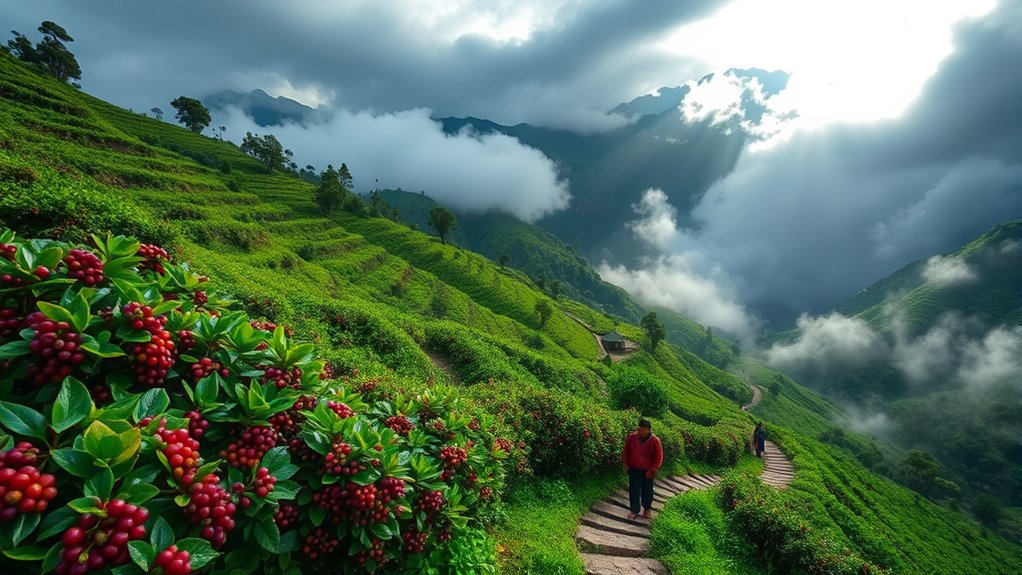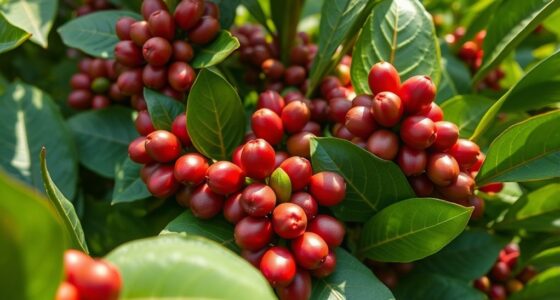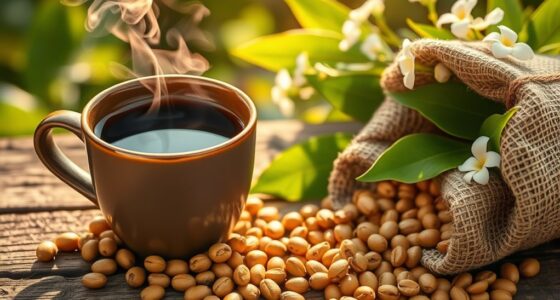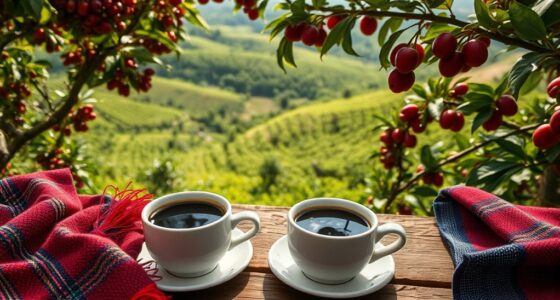Discover Peru’s highland coffee, a hidden gem of the Andes that showcases traditional cultivation methods, high-altitude growth, and vibrant cultural traditions. Hand-harvested by locals using sustainable techniques, these coffees develop complex flavors with a bright, rich depth. The unique environment of volcanic soil and microclimates enhances their distinctiveness. By exploring these communities, you’ll uncover the remarkable craftsmanship behind each cup—and learn how centuries of heritage shape every sip.
Key Takeaways
- Peru’s highland coffee is cultivated by small-scale farmers using traditional, sustainable methods that emphasize quality and environmental preservation.
- Mountainous terrain and volcanic soils create unique microclimates, enriching the coffee’s flavor profile with brightness and depth.
- Hand-harvesting ripest cherries and traditional processing techniques enhance the complex, nuanced flavors of Highland coffee.
- Coffee holds deep cultural significance, celebrated through local festivals and community rituals that foster craftsmanship and heritage.
- The region’s emphasis on organic, eco-friendly practices supports both high-quality beans and long-term environmental sustainability.

Have you ever wondered what makes Peru’s highland coffee so exceptional? The answer lies in the unique blend of coffee cultivation techniques and deep-rooted Highland traditions that date back generations. In the Andes, coffee cultivation isn’t just a farming activity; it’s a way of life. Small-scale farmers carefully tend to their coffee plants, often by hand, in high-altitude regions where the cool mountain air and fertile volcanic soil create perfect conditions for growing high-quality beans. These farmers have perfected their craft over decades, passing down their knowledge through generations, maintaining a strong sense of Highland traditions that shape every step of the process.
The mountainous terrain offers more than just a stunning backdrop—it influences every aspect of coffee cultivation. The high elevation results in a slower bean maturation process, allowing the beans to develop a richer, more complex flavor profile. Farmers in these regions often work closely with their communities, sharing techniques and knowledge, which ensures that their coffee remains authentic and high in quality. The Highland traditions foster a deep respect for the land and the crops, emphasizing sustainable practices and organic methods that preserve the environment while producing superior beans. Additionally, the unique microclimates created by the terrain further enhance the distinctiveness of the flavor profiles.
You might notice that the coffee from Peru’s highlands carries a distinctive brightness and depth, attributes that are directly linked to the traditional methods employed in its cultivation. Many farmers still harvest their coffee by hand, selecting only the ripest cherries, which guarantees a high-quality product. Post-harvest, they often use age-old processing methods, such as washed or honey processing, which enhance the beans’ natural flavors. These practices are deeply intertwined with Highland traditions, reflecting a cultural reverence for the land and a commitment to craftsmanship that’s been refined over generations.
In addition, the strong sense of community among Highland coffee farmers means they often collaborate to improve quality and share knowledge. This collective effort helps maintain the high standards that make Peru’s Highland coffee stand out globally. The local festivals and rituals connected to coffee harvesting also reinforce their Highland traditions, celebrating the crop as a vital part of their cultural identity. Sound design techniques and the careful preservation of traditional practices contribute to the unique sensory experience of each cup. Moreover, the integration of sustainable farming methods ensures the long-term health of the environment and the local economy. All of these elements—dedicated coffee cultivation, age-old traditions, and community bonds—combine to produce a coffee that’s not just a beverage but a story of perseverance, culture, and nature’s bounty. When you sip Peru’s Highland coffee, you’re tasting centuries of tradition and the passion of those who continue to nurture these exceptional beans.
Frequently Asked Questions
What Unique Flavors Distinguish Peruvian Highland Coffee From Other Regions?
You’ll notice that Peruvian highland coffee offers a unique flavor profile, thanks to the high-altitude growing conditions. It often features bright, crisp acidity with tasting notes of citrus, floral hints, and a subtle earthiness. These distinct flavors set it apart from coffees from other regions, giving you a vibrant, well-balanced cup that highlights the region’s rich soil and cool climate, making each sip a truly special experience.
How Is the Traditional Harvesting Process Conducted in the Andes?
You observe that traditional methods in the Andes involve hand picking techniques, where workers carefully select ripe coffee cherries. This meticulous process guarantees only the best cherries are harvested, preserving flavor and quality. Farmers typically pick cherries during the harvest season, often working in small groups. This traditional approach maintains the region’s unique coffee profile and supports sustainable practices, making Highland coffee distinct from other regions.
What Sustainable Practices Are Used in Peruvian Highland Coffee Cultivation?
You’ll find that sustainable practices in Peruvian highland coffee cultivation focus on organic certification and water conservation. Farmers often adopt organic methods to avoid synthetic chemicals, protecting the environment and ensuring healthier beans. Water conservation techniques, like drip irrigation and rainwater harvesting, help reduce water use and preserve local water sources. These practices support eco-friendly growth, benefiting both the land and the communities that depend on coffee farming.
Which Peruvian Highland Coffee Varieties Are Most Popular Internationally?
Ever wonder which Peruvian highland coffee varieties capture international attention? You’ll find that varieties like Typica and Bourbon are most popular, thanks to their rich flavor profiles and aromatic qualities. These beans considerably contribute to Peru’s coffee export success, showcasing unique tastes that appeal worldwide. Are you ready to explore the vibrant flavors of Peru’s highland coffees? Their distinctive qualities make them truly stand out on the global stage.
Are There Local Festivals Celebrating Highland Coffee in Peru?
You’ll find that coffee festivals and cultural celebrations are vibrant parts of Peru’s highland regions. These events often showcase local coffee varieties, highlighting their importance to community heritage. During these festivals, you can enjoy coffee tastings, traditional music, and dances that celebrate the rich history of Peruvian highland coffee. Participating in these festivals gives you a deeper appreciation for the cultural significance of coffee in Peru’s highlands.
Conclusion
Now that you’ve discovered Peru’s highland coffee, aren’t you enthusiastic to taste its unique flavors? These hidden gems of the Andes offer more than just a great brew—they provide a glimpse into a rich tradition and vibrant culture. By exploring these farms, you’re not only savoring exceptional coffee but also supporting local communities. So, aren’t you ready to experience the magic of Peru’s highland coffee firsthand? Your taste buds will thank you.









